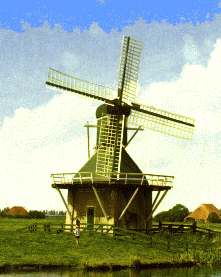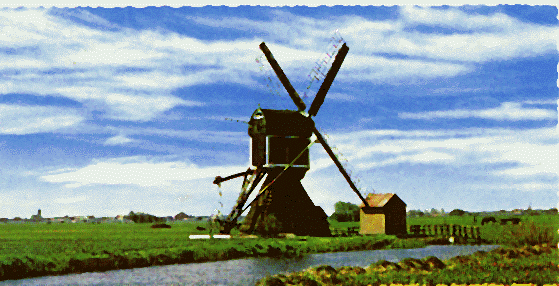LETTER OF SCHOOLMASTER DE VRIES

Suiderbaanstr. 4
DOKKUM
tel. 05190-2801
With great interest I took notice of your letter which because of the incomplete address arrived me only a couple of days ago after many detours.
I would gladly help you in your efforts to make up your complete family-tree but regretfully I am unable to do that, because I did some genealogy only very indirectly during my study of Warga. Only life conditions and events in the lands of the northern part of Idaarderadeel (1) during a period that goes from the 12th until the 20th century had my attention. Of course did I come across many names, but I did not take time out for genealogy lists.
I understand though that my friendly and loyal ex-neighbors Cath. and Feikje Boekema adviced you to write me for the occasion. During one of my lectures which I gave then in Warga I mentioned that the Catholic group in the population of Warga-Wartena was noimport, but descended from ancestors who centuries before the reformation lived already there and that the families Boekema and Jurna belonged to the oldest generations of Warga. Catharinus and Feikje kept that in their ears of course. I shall now explain you more in details whereupon this affirmation was founded.
In 1968 Sijtse Jelles bought from Douwe Nikolaas Sijmons « a piece of land laying in the (« droog gemalen ») Jornahuister lake which through windmill power had been emptied and according to tradition (« naer naem and faem ») eighty « pondematen » (one « pondemaat »= 36.78 acres) big, plus the house, the barn, the garden (« hovinge »), the trees and the plantation next to the watermill, accept..., giving up the benefits, in goldbars and good money (« in baren gelde ende klinkende munte », thus no paper-money: C.B.) without landscape obligations in two terms primo in may and pino in may the year thereafter a sum of a total count of thousand fifty six carats of gold, thirteen nickels and 6 pennies; tom may this year; tom the year thereafter the other half. »
I suppose that this kind of jargon (« kanselarij-taal ») is clear enough to you: the huge sum (quite a capital in those days) had to be paid in two years, the first half in 1698 and the second half (tom.- as a matter of fact: tomus, thus part) in 1699.
I copied only a part of this sales-act, but I am mainly interested in the word trees which I underlined.
Indeed, in 1716 this place is sold again by Sijtse Jelles and the sales-act declares then that it "belonged earlier to Douwe Klaas van de Boeken". In 1731 a process was held concerning the same place at the court of Friesland and this shows that the place belonged in 1698 to Douwe Klaas Boekema and before that to many generations of his family ». Thus it appears that the name of the family who came from the place with the « boeken » (=beeches: C .B .), became common use by the inhabitants of the village and also by the authorities. You know the Frisian language well enough to translate « boekebeam » (beechtree: C .B. ). Indeed, in front of this « place » (farm is also called in Frisian« pleats »; using the Dutch word « plaats » which means « place », de Vries plays with the two meanings: C.B.) stood for centuries three tall beeches and that was a rarity in the watery countries around Warga where the beech would not grow. A little sandhill (« zandkop »=« gaast ») under the grasland which run alongside the original Jornahuister lake and locally almost surfaced made it possible for those trees to grow there (2).
Your ancestry therefore can be traced down from those many generations who before Douwe Klaas Boekema and thus before 1698 resided at that place. But it will not be easy. A farm remaining generations long in the same family is not rented out nor sold and no official acts are drawn concerning it. Marriage-, baptismal-records and the funeral register therefore have to help you out. The funeral register of the Dutch Reformed Church in Warga in which cemetery the catholics were also burried, goes alas only back until 1709. The marriage- and baptismal records of the station (« statie »= post of an appointed catholic priest: C.B.) are very incomplete and also not always trustworthy, seemingly on purpose kept incomplete in the difficult years for the catholics in Friesland from 1580 until the middle of the 17th century.
But nevertheless, in the history of Warga the family goes much further back. In the Register of declaration and presence (« van Aanbreng en opkomste »= probably, what people possess and who or where they are: C.B. ) of 1580 finds himself as an important landowner in Warga on the same farm which in 1698 was sold by Douwe Klaas Boekema a certain Nicolaas Thomas, son of Douwe Nicolaas, while after his name is written « this person is a papist ». Finally, the Register of declaration of 1511 mentions as the most important landowner in Warga (after « Sir Pastor » (parishpriest: C.B.), « Sir Vicarus (curate; C.B.) and « the Patrona »(the Church), who were the greatest landowners with 764 of a total of around 2000 « pondematen ») Douwa Jouws and his wife Regina Barbera. They owned and farmed by themselves « 25 pondem. fennen, 52 pond.m. meden en 4 pondem. seedlandt »(respectively grasland, hayland and cultivated land). They lived on the same farmstead as centuries later their descendant Douwe Klaas Boekema and if you add their landproperty up it shows that the place has still the same size as what Boekema sold in 1698. It is my firm conviction that Douwe from 1698 descends from Douwa Jouws and Regina Barbera from 1511. Also because in 1580 again a Nicolaas Thomas, son of Douwe Nicolaas, is present and those « many generations » mentioned in the court-case of 1731 span certainly an era of 150 years, otherwise another expression would have been used.
Maybe you will agree now with me that the Boekema family belongs to one of the most important and influential generations in Warga and that the family resides there already since the late Middle Ages.
Maybe would you like to know what happened with Douwe Klaas Boekema when in 1698 he sold his old family farm. Well that is very simple: he bought another much larger farmstead also situated in Warga.
Until in the middle of the 19th century the big landproperty of this place stays in the family. Afterwards the farm is partitioned through heritage, the Boekema’s having usually large households. During the French period a Boekema is still one of the leaders of the patriotic club in Warga, but this one is no longer a farmer but an « oliemolenaar » ( miller with an oilmill: C.B.).
There have been many ups and downs, like in any ancient family, but over and over again I came across Boekema’s or the to them related Jurna’s (also named sometimes Jorna’s) (3). Those Jurna’s resided for centuries on Jornahouse and were thus also for centuries neighbors of the (more later) Boekema’s. The family remained always catholic, also during the very difficult times between 1550 and 1670. A family to be proud of: Loyal, perseverant, honest, ready to make sacrifices and when necessary also courageously facing the perils of a conviction which in those years in Friesland was lifethreatening. No people of many words, but men of deeds and women with a warm heart!
Until the nearby past it remained this way: Was indeed in 1889 Jan Boekema not one of the seven courageous farmers in Warga, who not withstanding all the disrespect and mockery from outsiders and also of colleagues in Warga founded the first cooperative steamfactory for dairy products and thereby stimulated the efflorescence as never before of the peasantry in Friesland. (4)
Before you travel back to Canada, reverend Father, I suppose that you will again go to Warga and ask Catharinus Boekema to show you the farm of the Brothers De Boer on the dike of the Jornahuister lake « polder » (land which was under water before dikes were built: C.B.). There is no longer a stone left from that earlier farm, neither of the small roman catholic clandestine church (« schuilkerk ») which your ancestors permitted to be built on their property in 1696 and which was the roman catholic church for the people of Warga and Wartena until 1865, but on those grounds lay many footsteps of many ancestors of your family.
I hope that you or another member of your family will succeed to figure out that whole series of names which starts in 1511 with Douwa Jouws (or maybe yet earlier!) and lasts until these days.
Should you yet make that pilgrimage, would you then bring Catharinus and Feikje the warm greetings of my wife and myself. Hopefully my explanation will aid you in some way even if I could not forward you a complete genealogy. To a member of the family who meant so much for my dear Warga I loved to give my data and of my time. Most respectfully.
Those villages belong now to Boarnsterhim (pop. 17.800), as is the case of the villages of Rauwerderhem (Deersum, Irnsum (my hometown), Poppingawier, Rauwerd, Sijbrandaburen and Terzool) and the villages of Utingeradeel (Akkrum, Akmarijk, Nes, Oldeboorn, Terhorne and Terkaple.
(2) We find the word « gaast » also in « Gaasterland » a region in Friesland close to the Ijselmeer, originally the Zuiderzee. Maybe the sandhill in Warga was a remainder of the famous St-Elisabeth flood in the 12th century. Or goes it back to prehistoric times? Geologist should explain this to us.
(3) Until now we have not yet found Jurna’s or Jorna’s in our familytree. Schoolmaster de Vries researched the era from the 12th until the 20th century, while our data until now go no further back as the middle of the 18th century. Thus it seems that marriages between Boekema’s and Jurna’s (Jorna’s) have taken place before that time.
(4) This Jan Boekema is JAN KLASIS. The dairy factory became the international renowned FRICO factories, not the ones founded in Sweden in 1932 by Friberg & Co, Experts in energy effective heating, but those who are now known as FRIESLAND Frico Domo . By surfing I learned also that "frico" is a traditional dish from the Italian region of Friuli, hence the Frico Bar in New York City ;-)
Translation by C.Boekema, January 1998.
 Return to Introduction
Return to Introduction